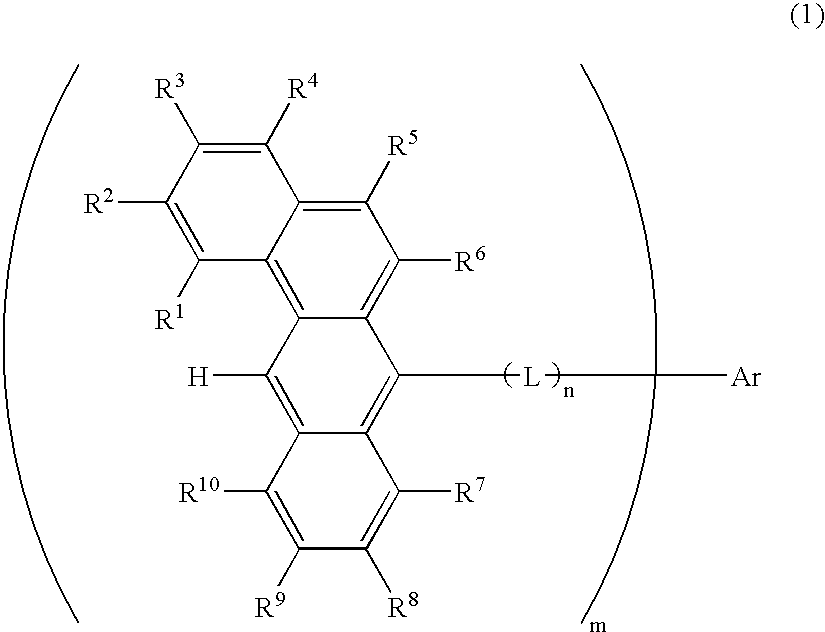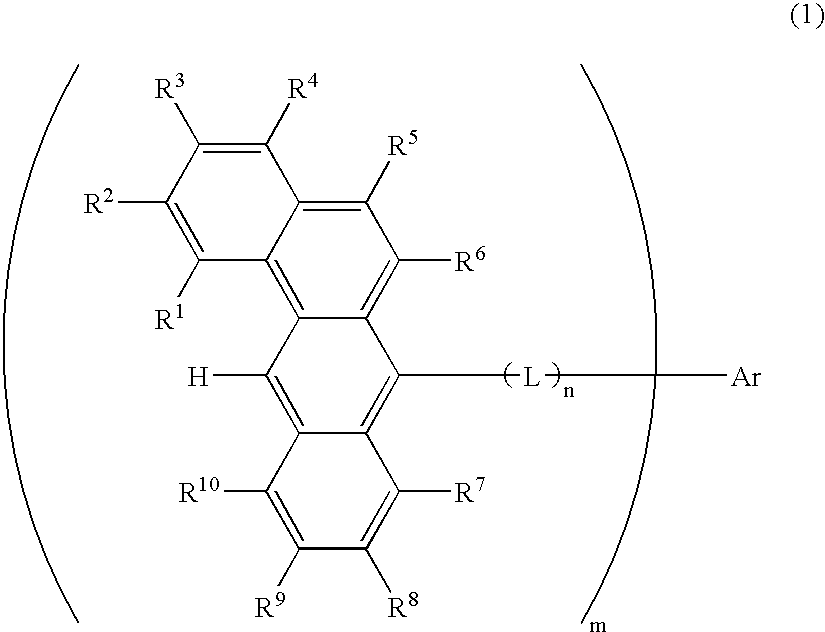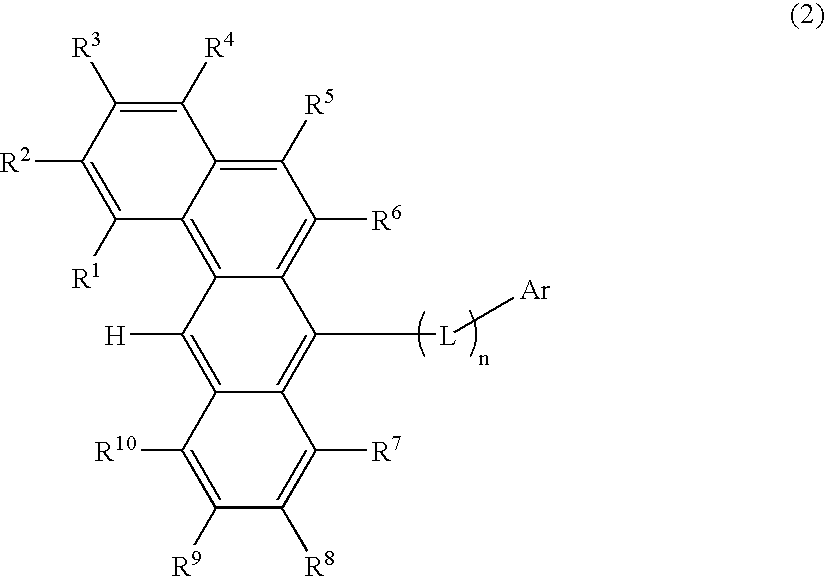Benzanthracene derivative and electroluminescence device using the same
a technology of benzanthracene and derivative, applied in the direction of discharge tube luminescnet screen, other domestic articles, organic chemistry, etc., can solve the problems of insufficient life of obtained device and inability to exhibit excellent chromaticity, and achieve excellent chromaticity and great light emission efficiency
- Summary
- Abstract
- Description
- Claims
- Application Information
AI Technical Summary
Benefits of technology
Problems solved by technology
Method used
Image
Examples
synthesis example 1 (
Synthesis of BAN-2)
[0123] Into 300 ml of DMF, 40 g of commercial benzanthracene was dispersed, and 35.6 g of NBS was added to the resultant suspension at the room temperature. After the resultant mixture was stirred for 3.5 hours, 600 ml of water was added, and the formed crystals were separated by filtration and washed with methanol. The obtained crude crystals were purified using a silica gel column with toluene and filtered with hexane, and 49.3 g of 7-bromobenzanthracene was obtained as cream crystals (the yield: 91%).
[0124] Into 200 ml of dehydrated THF, 20 g of 7-bromobenzanthracene obtained above was dissolved, and the obtained solution was cooled at −62° C. To the cooled solution, 50 ml of a 1.6 M hexane solution of normal-butyllithium was added dropwise, and the resultant mixture was stirred for 30 minutes. The temperature was raised to −5° C. and then lowered to −64° C. To the cooled fluid, a THF solution of 22.4 g of trimethyl borate was added dropwise. After one night, ...
synthesis example 2 (
Synthesis of BAN-3)
[0126] Under the atmosphere of argon, 4.4 g of 3-(naphthalen-2-yl)phenyl-boronic acid synthesized in accordance with a conventional process and 5 g of 7-bromobenzanthracene were dispersed into 60 ml of toluene, and 26 ml of a 2M aqueous solution of sodium carbonate was added to the resultant dispersion. To the obtained mixture, 0.57 g of tetrakis-triphenylphosphinepalladium was added, and the resultant mixture was heated under the refluxing condition for 7 hours. After one night, the formed precipitates were removed by filtration, and the mother liquor was washed with water and a saturated aqueous solution of sodium chloride. The organic layer was dried with anhydrous sodium sulfate, and the solvent was removed by distillation. The obtained residue was crystallized from toluene / hexane, and 4.3 g of the object compound (BAN-3) was obtained as grayish white crystals (the yield: 61%). When the obtained compound was examined in accordance with the field desorption mas...
synthesis example 3 (
Synthesis of BAN-17)
[0127] Under the atmosphere of argon, 2.65 g of p-dibromobenzene and 6.7 g of 7-benzanthraceneboronic acid were dispersed into 80 ml of toluene and 80 ml of DME, and 40 ml of a 2M aqueous solution of sodium carbonate was added to the resultant dispersion. To the obtained mixture, 0.78 g of tetrakistriphenylphosphinepalladium was added, and the resultant mixture was heated under the refluxing condition for 8 hours. After one night, the formed precipitates were separated by filtration. The obtained crystals were washed with water, methanol and heated toluene, and 4.6 g of the object compound (BAN-17) was obtained as grayish white crystals (the yield: 78%). When the obtained compound was examined in accordance with the field desorption mass spectroscopy (FD-MS), it was found that m / z=530, which agreed with C42H26=530, and the above compound was identified to be BAN-17.
PUM
| Property | Measurement | Unit |
|---|---|---|
| transmittance | aaaaa | aaaaa |
| work function | aaaaa | aaaaa |
| transmittance | aaaaa | aaaaa |
Abstract
Description
Claims
Application Information
 Login to View More
Login to View More - R&D
- Intellectual Property
- Life Sciences
- Materials
- Tech Scout
- Unparalleled Data Quality
- Higher Quality Content
- 60% Fewer Hallucinations
Browse by: Latest US Patents, China's latest patents, Technical Efficacy Thesaurus, Application Domain, Technology Topic, Popular Technical Reports.
© 2025 PatSnap. All rights reserved.Legal|Privacy policy|Modern Slavery Act Transparency Statement|Sitemap|About US| Contact US: help@patsnap.com



